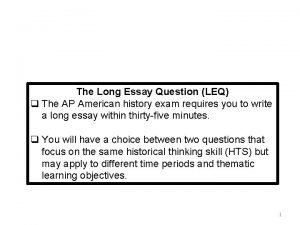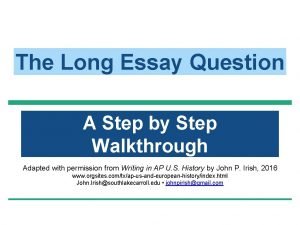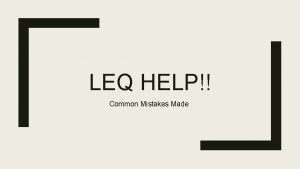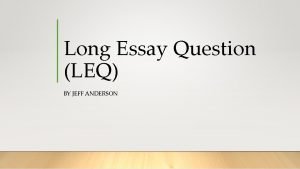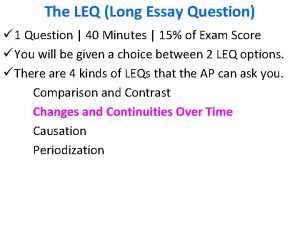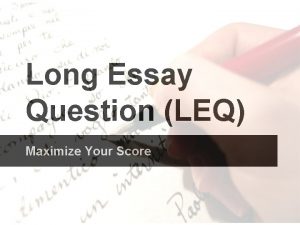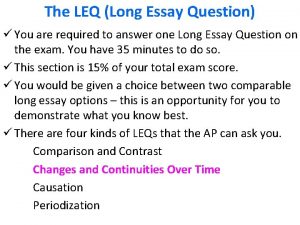LEQ Long Essay Question THESIS 1 point Responds








- Slides: 8

LEQ Long Essay Question

THESIS = 1 point • Responds to the prompt with a historically defensible thesis/claim that establishes a line of reasoning. The thesis must make a claim that responds to the prompt, rather than restating or rephrasing the prompt. • Scoring Note: The thesis must consist of one or more sentences located in one place, either in the introduction or the conclusion.

CONTEXTUALIZATION = 1 point • Situates the prompt by explaining the broader historical events, developments, or processes immediately relevant to the question. • Scoring Note: Contextualization requires using knowledge not found in the prompt to situate the argument within broader historical events, developments, or processes immediately relevant to the question. The contextualization point is not awarded for merely a phrase or reference, but instead requires an explanation, typically consisting of multiple sentences or a full paragraph.

EVIDENCE = 2 points • 1 Point - Provides specific examples of evidence relevant to the topic of the prompt. • 1 Point - Supports an argument in response to the prompt using specific and relevant examples of evidence. • Scoring Note: To earn one point, the response must identify specific historical examples of relevant evidence, whereas to earn two points, the response must use the specific historical evidence to support an argument in response to the prompt.

ANALYSIS & REASONING = 2 points • 1 Point - Uses historical reasoning (e. g. comparison, causation, CCOT) to frame or structure an argument that addresses the prompt. • Scoring Note: To earn the first point, the response must demonstrate the use of historical reasoning to frame or structure an argument, although the reasoning might be uneven or imbalanced.

• 1 Point - Demonstrates a complex understanding of the historical development that is the focus of the prompt, using evidence to corroborate, qualify, or modify an argument that addresses the question. This understanding must be part of the argument, not simply a phrase or reference. • A response might demonstrate complex understanding in a number of ways, such as: a) Explaining nuance of an issue by analyzing multiple variables b) Explaining both similarity and difference; explaining both continuity and change; explaining multiple causes; or explaining both cause and effect c) Explaining relevant and insightful connections within and across time periods d) Confirming the validity of an argument by corroborating multiple perspectives across themes e) Qualifying or modifying an argument by considering diverse or alternative views or evidence

Sample Qs from the Textbook • Analyze the continuities and changes in Mesoamerican society from the time of the Olmec to the post-classic period 1200 BCE to 1300 CE • Compare the process of state formation in Andean South America and Mesoamerica

Helpful Words Similarity • Also • As well • Both/all • Comparable • Equally • Furthermore • In addition • In common • In comparison • In this manner is like • Just like (just as) • Like (likewise) • Neither (in certain cases) • Shares • Similarly (similar to) • Too Difference • Although/Even though • But • Compared to • Conversely • Differently (different than/from) • However • In contrast with/to • In spite of (despite) • In this manner is unlike • Instead of • Nevertheless • On the other hand, on the contrary • Otherwise • Unlike • While




